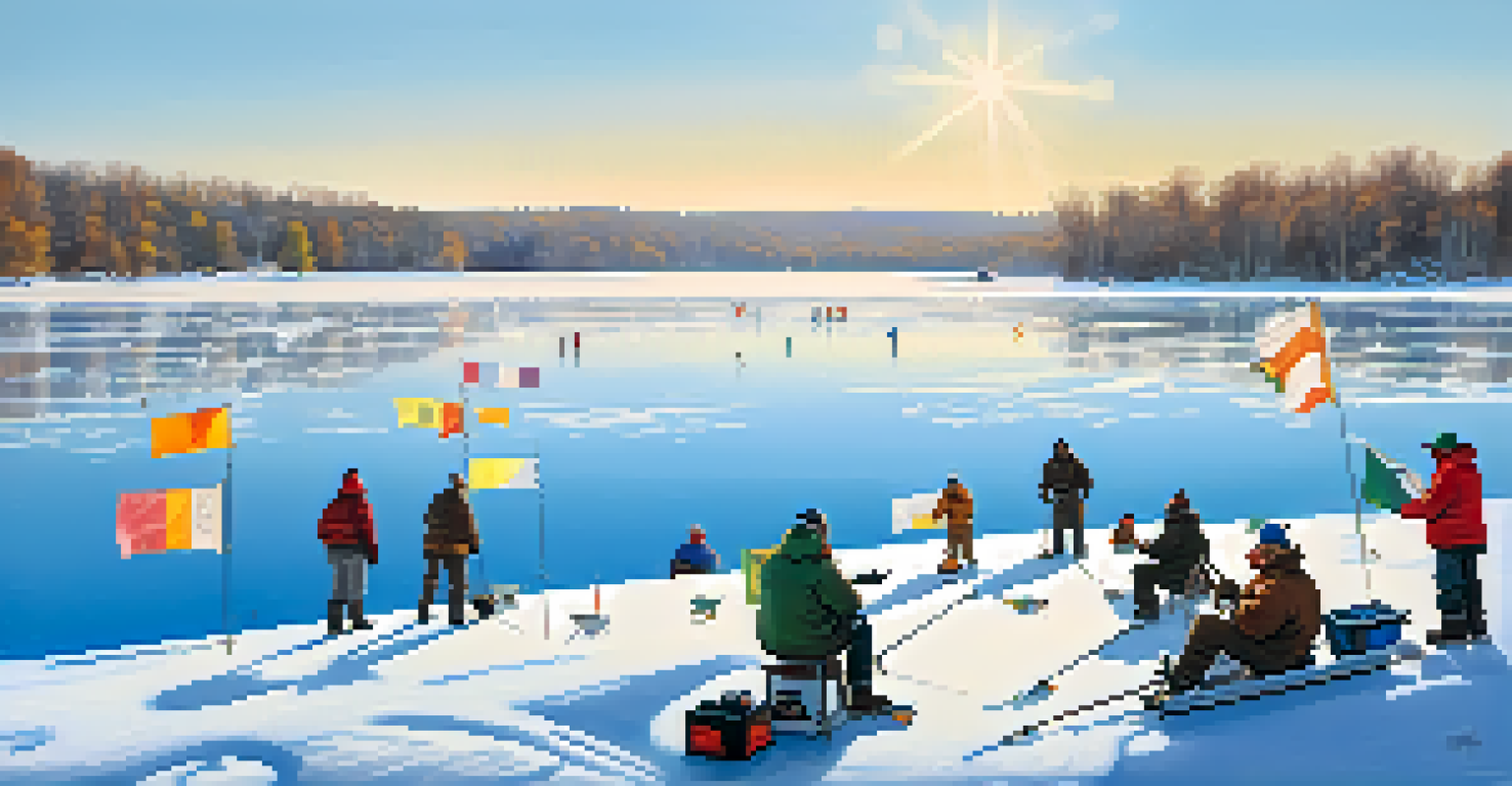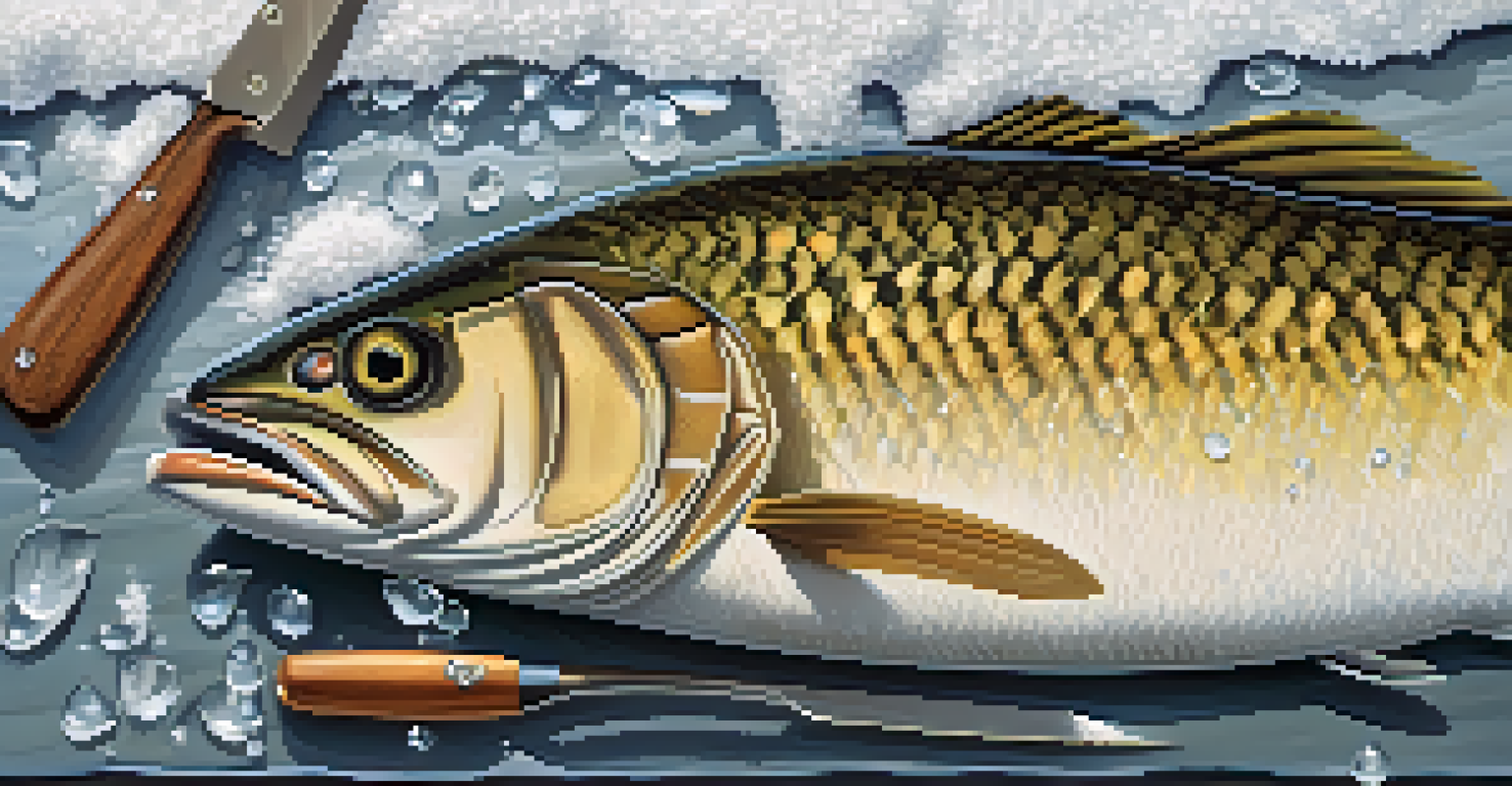The Art of Ice Fishing: Techniques for Winter Anglers

Understanding Ice Fishing Basics for Beginners
Ice fishing is a unique outdoor experience that combines patience and skill. Before you venture out, it’s crucial to understand the basics, such as the type of equipment you'll need and the best locations to fish. Familiarizing yourself with local fishing regulations is essential to ensure a legal and safe outing.
Fishing is not an escape from life, but often a deeper immersion into it.
Start by learning about the different types of ice fishing gear, from rods and reels to bait and tackle. Each piece has its purpose and can significantly affect your catch rate. For beginners, it’s often best to rent equipment or borrow from experienced friends to get a feel for what works.
Safety should be your top priority as you traverse frozen lakes. Always check ice thickness and clarity before setting foot on it. Generally, ice should be at least 4 inches thick for safe walking, but local guidelines may vary, so always stay informed.
Choosing the Right Location for Ice Fishing
Location is everything in ice fishing, just like in real estate. Finding the right spot can mean the difference between a barren day and a full cooler. Look for areas with structures like drop-offs, underwater vegetation, or natural currents, as these are often fish hotspots.

Using a fish finder can greatly enhance your chances of locating fish beneath the ice. This handy device helps you see the underwater landscape, including depth and fish movement. If you don’t have one, consider spending time observing other anglers to see where they are having success.
Prioritize Safety on the Ice
Ensure safety by checking ice thickness, fishing with a buddy, and staying informed about weather conditions.
Don’t forget to consider the time of day when planning your fishing adventure. Early mornings and late afternoons are typically more productive as fish tend to be more active during these hours. Adapting your schedule to these prime times can increase your chances of a successful outing.
Essential Ice Fishing Gear for a Successful Trip
Equipping yourself with the right gear is crucial for a successful ice fishing experience. At a minimum, you’ll need an ice auger to drill holes, a rod and reel combo designed for ice fishing, and appropriate bait. Depending on your target fish species, you may also want specialized tackle.
The charm of fishing is that it is the pursuit of what is elusive but attainable, a perpetual series of occasions for hope.
Clothing is another essential aspect that can’t be overlooked. Dressing in layers will keep you warm while allowing you to adjust to changing temperatures. Waterproof boots and insulated gloves are also vital for maintaining comfort during long hours on the ice.
Finally, consider bringing along additional items like a sled for transporting gear, a portable shelter for warmth, and a first-aid kit for safety. Being prepared with the right equipment helps ensure your focus remains on enjoying the fishing experience.
Effective Techniques for Ice Fishing Success
Once you're set up, employing the right techniques is key to reeling in that big catch. One popular method is jigging, which involves moving your bait up and down to attract fish. Experimenting with different jigging motions can help you find what works best for the species you’re targeting.
Another effective technique is using tip-ups, which allow you to fish multiple holes at once without constant attention. These devices signal you when a fish is biting, giving you the freedom to relax or engage in other activities while you wait for a catch.
Choose the Right Fishing Location
Successful ice fishing depends on selecting locations with underwater structures and observing fish activity.
Don’t forget to stay observant of your surroundings. Watching for signs of fish activity, such as jumping fish or ripples in the ice, can provide valuable clues. Adjusting your tactics based on real-time observations can significantly enhance your success rate.
Understanding Seasonal Patterns in Ice Fishing
Fish behavior changes throughout the winter months, influenced by factors like temperature and food availability. Understanding these seasonal patterns can greatly improve your chances of success. For instance, as winter progresses, fish tend to move to deeper waters in search of more stable temperatures.
In early winter, fish are often found in shallower areas as they feed heavily after spawning. This is the ideal time for anglers to target them in shallow bays or near submerged structures. As the season progresses, you may need to adjust your location to match the fish's changing habits.
Keeping a fishing log can help you track these patterns over time. Jotting down your observations, including weather conditions and successful bait types, provides valuable insights for future ice fishing trips. This practice can turn you into a more strategic angler.
Safety Tips for Ice Fishing in Winter Conditions
While ice fishing can be an exhilarating experience, it’s important to prioritize safety at all times. Always fish with a buddy, as having someone with you can be crucial in an emergency. If you find yourself in a precarious situation, don’t hesitate to call for help.
Before heading out, check local weather conditions and ice reports to assess safety. Keep an eye on temperature fluctuations, as warming can lead to unstable ice. Carrying safety gear, like a life jacket and ice picks, can make a big difference in case of an accident.
Equip Yourself with Essential Gear
Having the right ice fishing equipment, including clothing and tools, is crucial for a comfortable and successful experience.
Lastly, be aware of your surroundings. Other anglers, wildlife, and even changing weather conditions can all pose risks. Staying vigilant and prepared will not only keep you safe but also help you enjoy your time on the ice.
Cleaning and Cooking Your Ice Fishing Catch
Bringing home your catch is just the beginning of the ice fishing adventure. Properly cleaning and storing your fish is essential to ensure freshness and flavor. Start by using a sharp knife to scale and gut the fish, making sure to remove all entrails for the best taste.
After cleaning, it’s crucial to store your catch properly. If you plan to eat the fish soon, keep it on ice to maintain freshness. For longer storage, consider freezing the cleaned fish, wrapping it tightly to prevent freezer burn.

When it comes to cooking your catch, the options are endless. From grilling to frying, fresh fish can be a delightful addition to any meal. Experimenting with different recipes will not only showcase your catch but also create memorable dining experiences with family and friends.